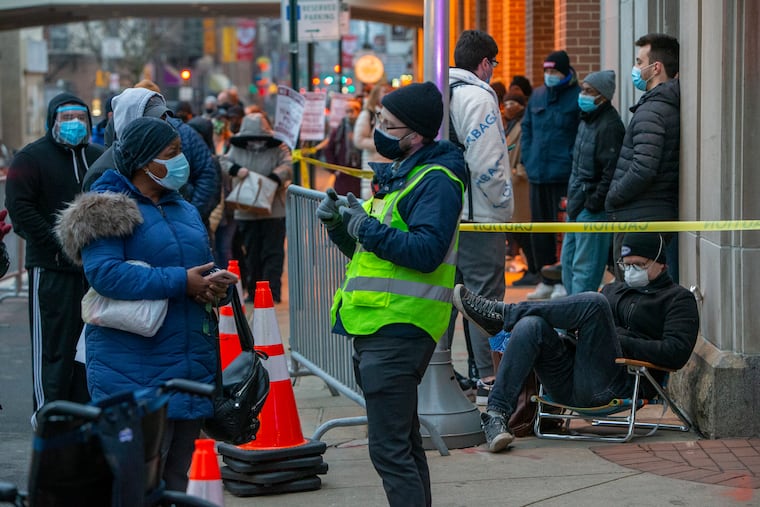I don’t mistrust vaccines. I mistrust government distribution. | Opinion
The proportion of white people nationwide who have received at least one dose far exceeds that of other racial and ethnic groups.

I don’t lack trust in any of the available vaccines. I do, however, mistrust their distribution. Most commentary on the disparities in vaccination rates among white, Black, and Latino populations has focused on vaccine hesitancy and mistrust as driving poor immunization rates for people of color. The narratives attempt to explain a crisis by saying: People of color don’t choose vaccination.
I disagree. What we really have is a crisis of biased distribution that overlooks communities of color.
Listen. Mislabeling all Black and Latino people as vaccine-hesitant is a distraction. It delegitimizes the potentially high acceptance of lifesaving vaccines for people of color. And when it comes to actually delivering shots, public officials are doing well only for white arms. The proportion of white people nationwide who have received at least one dose of a COVID-19 vaccination far exceeds that of other racial and ethnic groups. Nearly double — about 13% — of eligible white people have been vaccinated, compared with approximately 7% of Black and 5% of Latino people. This is despite Black people being overrepresented in COVID-19 related deaths at a ratio 1.9 times of whites, while Latinos and Indigenous populations suffer death due to COVID-19 at 2.3 and 2.4 times the rate of whites, according to the Centers for Disease Control and Prevention.
» READ MORE: Why are Black people being treated like America’s vaccine hesitancy problem? | Opinion
Why aren’t we replicating the strategies that worked for, say, voting? During the 2020 election, volunteers flocked into Black and Latino communities exacting measures that made voting accessible. This was particularly the case in Pennsylvania, where massive voting campaigns reached primarily Black neighborhoods of Philadelphia. Or perhaps we can use similar tactics to those that reach communities of color working in essential farm labor. Each year, Pennsylvania’s agriculture industry shores up its reliance on a primarily Latino workforce by using programs like H-2A visas as well as the Agricultural Recruitment System, which helps farm employers find temporary workers who are willing to live away from their homes. To date, nearly 80% of Pennsylvania’s farmworkers are Latino, suggesting the government can find their way to people of color when revenue is involved.
Yet Pennsylvania’s statewide data — excluding Philadelphia because of reporting differences — has the largest gap in vaccinations between white people and people of color, per a Kaiser Health News analysis published March 3. The data showed white residents were vaccinated at a rate 3.6 times that of Black people, 4.9 times that of Latino people, and a whopping 24.8 times that of Asian people. This is particularly surprising, because the vaccination rates of Asian residents looked close to that of whites in almost every state — except Pennsylvania.
“Why aren’t we replicating the strategies that worked for say, voting?”
Shame on us. The Kaiser Family Foundation COVID-19 vaccine monitor adds to our picture that many Black and Latino adults are in fact eager, if not desperate, for a vaccine. Among their respondents, 41% of Latino respondents want to obtain the vaccine as soon as they can, compared with 39% of white respondents — while Latino populations continue to see extremely low vaccination rates. And though the percentage of Black adults who want the vaccine as soon as possible came in lowest at 28%, that difference alone does not explain vast gaps in vaccine distribution.
We also need to take a harder look at what “vaccine mistrust” means. Vaccine hesitancy is not synonymous with vaccine refusal. Although the face of the mistrust is inherent in vaccination decisions, strong empirical examination has not been performed to confirm that mistrust impedes vaccination. Indeed, it is possible for a person to be both vaccine-hesitant and still accept a vaccine when offered.
Medical research has affirmed vaccine hesitancy and refusal worldwide, and declines in public trust toward vaccination are a global issue. In the United States, vaccine hesitancy has been linked to both conservative and liberal ideologies, both higher and lower levels of education, higher median income, being white, and having a child who attends private school. This is perhaps unsurprising given that vaccine hesitancy and mistrust are inconsistently defined across studies, with some pointing to the source of information, how the vaccine was developed, or side effects.
» READ MORE: As vaccine distribution ramps up, so do efforts to care for Philly’s vulnerable immigrants
Still, credible research on demographic predictors of vaccination blows up the notion that not accepting vaccines is primarily a Black or Latino problem. For example, a 2016 study linked vaccine refusal to higher median income, holding a bachelor’s degree, being white, and speaking English as the primary language. Similar research suggests that higher-income individuals may perceive a greater risk of side effects from vaccination compared with lower- and middle-income individuals. And the percentage of Black and Latino Americans who said they were unsure about or did not want the vaccine dropped significantly since December and late February, an Axios poll found, showing that vaccine mistrust in our communities has already declined during the pandemic.
Data also suggest that interventions like provider communication and motivational interviewing play a central role in improving vaccine acceptance globally. This point reinforces that attitudes of vaccine hesitancy as the primary driver of gaps in vaccination rates among Black, Latino, and white U.S. adults may be a false narrative.
A better explanation for the current sad state of vaccine disparities is that distribution to Black and Latino people has failed.
Dr. Shedra Amy Snipes is a bio-cultural anthropologist who studies the role of race, ethnicity, culture, and equity in health. @ShedraAmySnipes